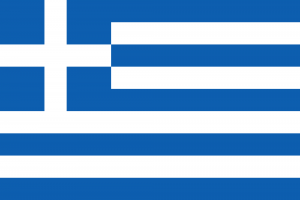Language/Modern-greek-1453/Vocabulary/Colors-and-shapes
In the previous lesson, we learned about family members and basic vocabulary related to relationships. We discovered how to describe family members and talk about family life in Modern Greek. In this lesson, we will explore the colorful world of colors and shapes. Learning the names of colors and basic shapes is essential for building a solid foundation in any language. So let's dive in and expand our vocabulary!
Colors[edit | edit source]
Colors add vibrancy and life to our surroundings. They evoke emotions and can even influence our moods. In Modern Greek, colors are no exception. Let's begin by learning some common colors:
- μαύρο (mávro) - black
- άσπρο (áspro) - white
- κόκκινο (kókkino) - red
- πράσινο (prásino) - green
- μπλε (mple) - blue
- κίτρινο (kítrino) - yellow
- πορτοκαλί (portokalí) - orange
- ροζ (roz) - pink
- καφέ (kafé) - brown
- γκρι (gkri) - gray
- μωβ (mov) - purple
These are just a few examples of colors in Modern Greek. By incorporating these words into your vocabulary, you will be able to describe the world around you with more precision and flair.
Basic Shapes[edit | edit source]
Shapes are everywhere in our environment. From the geometric patterns on buildings to the contours of natural objects, shapes play a significant role in our perception of the world. Let's explore some basic shapes in Modern Greek:
- κύκλος (kýklos) - circle
- τετράγωνο (tetrágono) - square
- τρίγωνο (trígono) - triangle
- ορθογώνιο (orthogónio) - rectangle
- παραλληλόγραμμο (parallēlógrammo) - parallelogram
- έλλειψη (éllipsis) - ellipse
- κύβος (kývos) - cube
- σφαίρα (sfaíra) - sphere
- κυλινδρικός (kylindrikós) - cylinder
- πυραμίδα (pyramída) - pyramid
By familiarizing yourself with these basic shapes, you will be able to describe and identify various objects with ease. Shapes are an integral part of our visual world, and learning their names in Modern Greek will enhance your language skills.
Cultural Significance[edit | edit source]
Colors and shapes hold cultural significance in various contexts. For example, in Greek mythology, specific colors were associated with gods and goddesses. The god Zeus was often depicted with a royal purple robe, symbolizing his power and authority. Similarly, the color blue was associated with the goddess Athena, representing wisdom and intelligence.
Shapes also have cultural significance in Greek art and architecture. The use of geometric shapes, such as triangles and squares, can be seen in ancient Greek temples and sculptures. These shapes were not only aesthetically pleasing but also held symbolic meaning.
Understanding the cultural significance of colors and shapes can provide valuable insights into Greek history, art, and mythology. It allows us to appreciate the rich cultural heritage of the Greek people and their contributions to the world.
Practice Exercises[edit | edit source]
To reinforce your learning, here are some practice exercises:
1. Match the color with its corresponding Greek word:
* Black - μαύρο * Green - πράσινο * Yellow - κίτρινο * Blue - μπλε * Red - κόκκινο
2. Identify the shape based on its description:
* A shape with four equal sides and four right angles - τετράγωνο * A shape with three sides - τρίγωνο * A shape with curved sides and no corners - κύκλος
3. Describe the cultural significance of the color blue in Greek mythology.
4. Research and find examples of Greek art or architecture that incorporate geometric shapes. Describe the symbolism behind these shapes.
Conclusion[edit | edit source]
Congratulations! You have expanded your vocabulary by learning the names of colors and basic shapes in Modern Greek. Colors and shapes are essential elements of our visual world, and by incorporating them into your vocabulary, you can better describe and understand the world around you. In the next lesson, we will explore the exciting world of hobbies and interests. So keep up the great work and continue your journey towards mastering Modern Greek!
Sources[edit | edit source]
Other Lessons[edit | edit source]
- Family and relationships
- Games and Toys
- Numbers
- Mall Walking
- Need
- Education
- Introductions and greetings in Modern Greek
- Dialogues
- Colors

